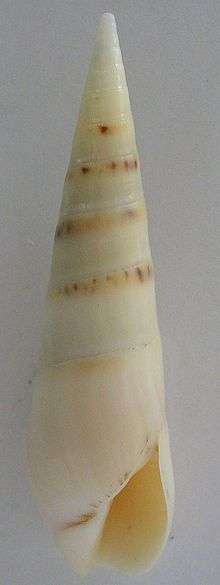Hastula hectica
| Hastula hectica | |
|---|---|
 | |
| Apertural view of a shell of Hastula hectica | |
| Scientific classification | |
| Kingdom: | Animalia |
| Phylum: | Mollusca |
| Class: | Gastropoda |
| (unranked): | clade Caenogastropoda clade Hypsogastropoda clade Neogastropoda |
| Superfamily: | Conoidea |
| Family: | Terebridae |
| Genus: | Hastula |
| Species: | H. hectica |
| Binomial name | |
| Hastula hectica (Linnaeus, 1758) | |
| Synonyms[1] | |
| |
Hastula hectica, common name the sandbeach auger, is a species of sea snail, a marine gastropod mollusk in the family Terebridae, the auger snails.[1]
The length of the shell varies between 30 mm and 80 mm.
Distribution
This species occurs in the Red Sea and the Indo-West Pacific.
References
- 1 2 Bouchet, P.; Terryn, Y. (2012). Hastula hectica (Linnaeus, 1758). Accessed through: World Register of Marine Species at http://www.marinespecies.org/aphia.php?p=taxdetails&id=217087 on 2012-10-14
- Dautzenberg, Ph. (1929). Contribution à l'étude de la faune de Madagascar: Mollusca marina testacea. Faune des colonies françaises, III(fasc. 4). Société d'Editions géographiques, maritimes et coloniales: Paris. 321-636, plates IV-VII pp.
- Bratcher T. & Cernohorsky W.O. (1987). Living terebras of the world. A monograph of the recent Terebridae of the world. American Malacologists, Melbourne, Florida & Burlington, Massachusetts. 240pp.
- Terryn Y. (2007). Terebridae: A Collectors Guide. Conchbooks & NaturalArt. 59pp + plates.
- Severns M. (2011) Shells of the Hawaiian Islands - The Sea Shells. Conchbooks, Hackenheim. 564 pp
- Castelin M., Puillandre N., Kantor Yu. I., Modica M.V., Terryn Y., Cruaud C., Bouchet P. & Holford M. (2012) Macroevolution of venom apparatus innovations in auger snails (Gastropoda; Conoidea; Terebridae). Molecular Phylogenetics and Evolution 64: 21-44
External links
This article is issued from Wikipedia - version of the 4/25/2013. The text is available under the Creative Commons Attribution/Share Alike but additional terms may apply for the media files.